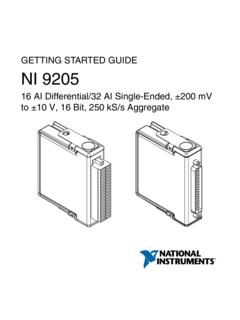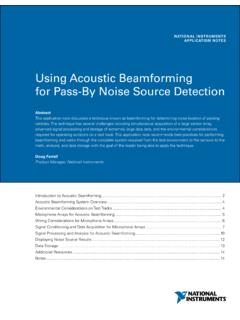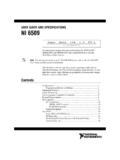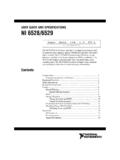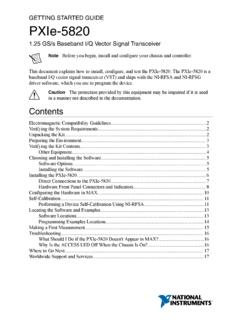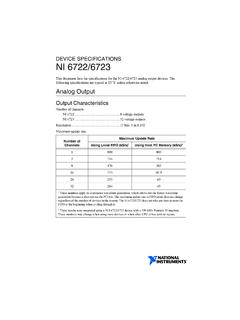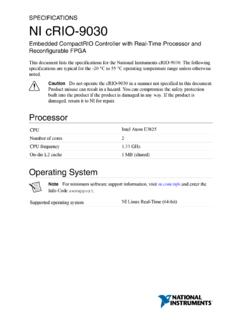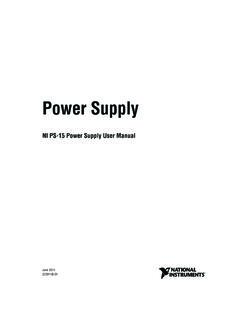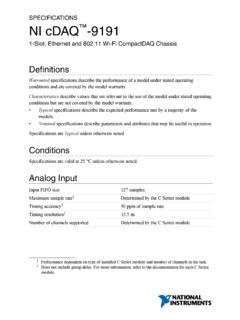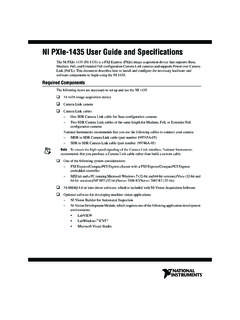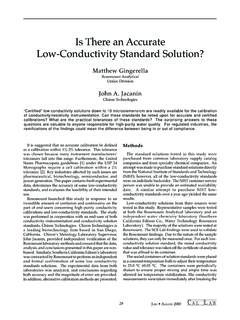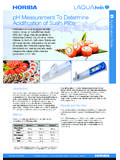Transcription of Smart TEDS sensor compatibility - National Instruments
1 DATASHEETNI 92344 AI, 5 V, 24 Bit, kS/s/ch Simultaneous, AC/DC Coupling, IEPEAC Coupling Software-selectable AC/DC coupling (AC coupled Hz) Software-selectable IEPE signal conditioningwith AC coupling (2 mA) -40 C to 70 C operating, 5 g vibration, 50 g shock 24-bit resolution Anti-aliasing filters 102 dB dynamic range Smart TEDS sensor compatibilityThe NI 9234 is a four-channel dynamic signal acquisition module for making high-accuracymeasurements from IEPE sensors. The NI 9234 delivers 102 dB of dynamic range andincorporates Integrated Electronics Piezoelectric (IEPE) signal conditioning at 2 mA constantcurrent for accelerometers and microphones. The four input channels simultaneously acquireat rates up to kS/s.
2 In addition, the module includes built-in anti-aliasing filters thatautomatically adjust to your sampling rate. Compatible with a single-module USB carrier andNI CompactDAQ and CompactRIO hardware, the NI 9234 is ideal for a wide variety ofmobile or portable applications such as industrial machine condition monitoring and in-vehiclenoise, vibration, and harshness ContentsRecommendedAccessories NI 9234 NI 9234 Getting Started Guide BNC Cable (x4) (779697-02)NI 9232NI 9234NI 9251 ConfigurationsIEPE with AC CouplingIsolationContinuousBNCN oise atMaximumSample Rate60 VDCCh-Ch50 VrmsConnectivity9-Position DSUB, LEMOS crewTerminalSample 30 V 5 V ProductNameNI 9218NI 9230 Signal Ranges2C SERIES ANALOG MODULE COMPARISON3 30 V 5 V XLRIEPE with AC Coupling,AC Coupling,DC Coupling IEPE with AC Coupling,AC Coupling,DC Coupling IEPE with AC Coupling,AC Coupling,DC Coupling AC Coupling,DC Coupling 106 Vrms251 Vrms50 Vrms60 VDCCh-Earth60 VDCCh-EarthNoneNI C Series OverviewNI provides more than 100 C Series modules for measurement, control, and communicationapplications.
3 C Series modules can connect to any sensor or bus and allow for high-accuracymeasurements that meet the demands of advanced data acquisition and control applications. Measurement-specific signal conditioning that connects to an array of sensors and signals Isolation options such as bank-to-bank, channel-to-channel, and channel-to-earth ground -40 C to 70 C temperature range to meet a variety of application and environmentalneeds Hot-swappableThe majority of C Series modules are supported in both CompactRIO and CompactDAQplatforms and you can move modules from one platform to the other with no | | NI 9234 DatasheetCompactRIOC ompactRIO combines an open-embedded architecturewith small size, extreme ruggedness, and C Seriesmodules in a platform powered by the NI LabVIEW reconfigurable I/O (RIO) architecture.
4 Each systemcontains an FPGA for custom timing, triggering, andprocessing with a wide array of available modular I/O tomeet any embedded application is a portable, rugged data acquisition platformthat integrates connectivity, data acquisition, and signalconditioning into modular I/O for directly interfacing to anysensor or signal. Using CompactDAQ with LabVIEW, youcan easily customize how you acquire, analyze, visualize,and manage your measurement Professional Development System for Windows Use advanced software tools for large project development Generate code automatically using DAQ Assistant and InstrumentI/O Assistant Use advanced measurement analysis and digital signal processing Take advantage of open connectivity with DLLs, ActiveX,and.
5 NET objects Build DLLs, executables, and MSI installersNI LabVIEW FPGA Module Design FPGA applications for NI RIO hardware Program with the same graphical environment used for desktop andreal-time applications Execute control algorithms with loop rates up to 300 MHz Implement custom timing and triggering logic, digital protocols, andDSP algorithms Incorporate existing HDL code and third-party IP including Xilinx IPgenerator functions Purchase as part of the LabVIEW Embedded Control and MonitoringSuiteNI 9234 Datasheet | National Instruments | 3NI LabVIEW Real-Time Module Design deterministic real-time applications with LabVIEW graphical programming Download to dedicated NI or third-party hardware for reliableexecution and a wide selection of I/O Take advantage of built-in PID control, signal processing, andanalysis functions Automatically take advantage of multicore CPUs or setprocessor affinity manually Take advantage of real-time OS, development and debuggingsupport.
6 And board support Purchase individually or as part of a LabVIEW suiteCircuitryThe input signal on each channel is buffered, conditioned, and then sampled by a 24-bit Delta-Sigma 1. NI 9234 Input Circuitry for One Channel2 mA IEPE on/offAI+AI-AmplifierandPrefilterADC+ AC/DC CouplingNI 9234 CommonModeBiasCurrentCurrentLimitingDiod es50 The NI 9234 analog input channels are referenced to chassis ground through a 50 minimize ground noise, make sure the chassis ground is connected to earth ground. Eachchannel is protected from CouplingYou can configure each channel in software for AC or DC coupling. For channels set to ACcoupling, you can turn the IEPE excitation current on or off. Refer to your software help formore information about configuring AC/DC coupling and enabling excitation 9234 TEDSThe NI 9234 also has TEDS circuitry.
7 For more information about TEDS, visit andenter the Info Code | | NI 9234 DatasheetFilteringThe NI 9234 uses a combination of analog and digital filtering to provide an accuraterepresentation of in-band signals and reject out-of-band signals. The filters discriminatebetween signals based on the frequency range, or bandwidth, of the signal. The three importantbandwidths to consider are the passband, the stopband, and the anti-imaging NI 9234 represents signals within the passband, as quantified primarily by passband rippleand phase nonlinearity. All signals that appear in the alias-free bandwidth are either unaliasedsignals or signals that have been filtered by at least the amount of the stopband signals within the passband have frequency-dependent gain or attenuation.
8 The smallamount of variation in gain with respect to frequency is called the passband flatness. Thedigital filters of the NI 9234 adjust the frequency range of the passband to match the data , the amount of gain or attenuation at a given frequency depends on the data 2. Typical Passband Response for the NI 9234 Frequency/Data (dB)StopbandThe filter significantly attenuates all signals above the stopband frequency. The primary goalof the filter is to prevent aliasing. Therefore, the stopband frequency scales precisely with thedata rate. The stopband rejection is the minimum amount of attenuation applied by the filter toall signals with frequencies within the BandwidthAny signals that appear in the alias-free bandwidth are not aliased artifacts of signals at ahigher frequency.
9 The alias-free bandwidth is defined by the ability of the filter to rejectfrequencies above the stopband frequency. The alias-free bandwidth is equal to the data rateminus the stopband 9234 Datasheet | National Instruments | 5 Data RatesThe frequency of a master timebase (fM) controls the data rate (fs) of the NI 9234. The NI 9234includes an internal master timebase with a frequency of MHz, but the module alsocan accept an external master timebase or export its own master timebase. To synchronize thedata rate of an NI 9234 with other modules that use master timebases to control sampling, allof the modules must share a single master timebase following equation provides the available data rates of the NI 9234: = 256 where n is any integer from 1 to , the data rate must remain within the appropriate data rate range.
10 When using theinternal master timebase of MHz, the result is data rates of kS/s, kS/s, kS/s, and so on down to kS/s, depending on the value of n. When using anexternal timebase with a frequency other than MHz, the NI 9234 has a different set ofdata The NI 9151 R Series Expansion chassis does not support sharing timebasesbetween 9234 SpecificationsThe following specifications are typical for the range -40 C to 70 C unless otherwise To ensure the specified EMC performance, operate this product only withshielded cables and Do not operate the NI 9234 in a manner not specified in this misuse can result in a hazard. You can compromise the safety protectionbuilt into the product if the product is damaged in any way.
